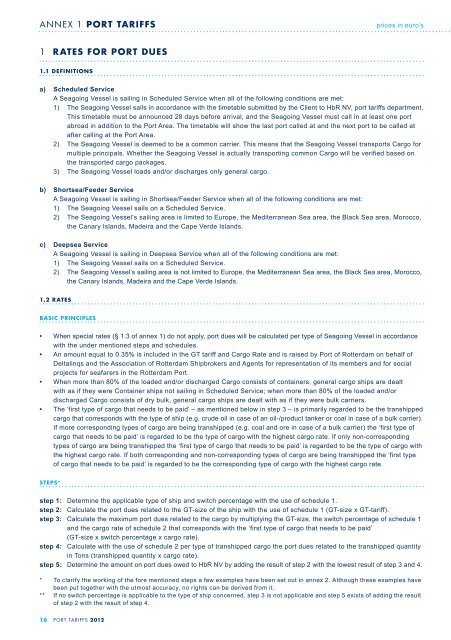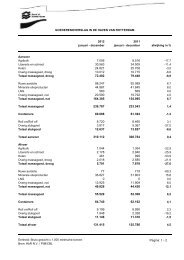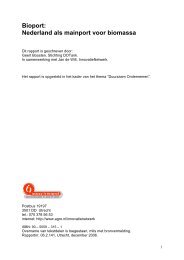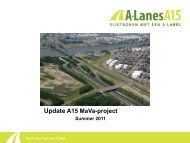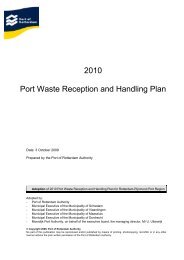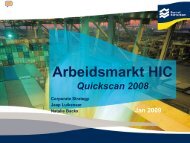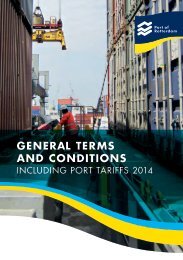Brochure (binnenwerk) 'General Terms and ... - Port of Rotterdam
Brochure (binnenwerk) 'General Terms and ... - Port of Rotterdam
Brochure (binnenwerk) 'General Terms and ... - Port of Rotterdam
Create successful ePaper yourself
Turn your PDF publications into a flip-book with our unique Google optimized e-Paper software.
ANNEX 1 PORT TARIFFS<br />
1 RATES FOR PORT DUES<br />
1.1 DEFINITIONS<br />
16 PORT TARIFFS 2012<br />
prices in euro’s<br />
a) Scheduled Service<br />
A Seagoing Vessel is sailing in Scheduled Service when all <strong>of</strong> the following conditions are met:<br />
1) The Seagoing Vessel sails in accordance with the timetable submitted by the Client to HbR NV, port tariffs department.<br />
This timetable must be announced 28 days before arrival, <strong>and</strong> the Seagoing Vessel must call in at least one port<br />
abroad in addition to the <strong>Port</strong> Area. The timetable will show the last port called at <strong>and</strong> the next port to be called at<br />
after calling at the <strong>Port</strong> Area.<br />
2) The Seagoing Vessel is deemed to be a common carrier. This means that the Seagoing Vessel transports Cargo for<br />
multiple principals. Whether the Seagoing Vessel is actually transporting common Cargo will be verified based on<br />
the transported cargo packages.<br />
3) The Seagoing Vessel loads <strong>and</strong>/or discharges only general cargo.<br />
b) Shortsea/Feeder Service<br />
A Seagoing Vessel is sailing in Shortsea/Feeder Service when all <strong>of</strong> the following conditions are met:<br />
1) The Seagoing Vessel sails on a Scheduled Service.<br />
2) The Seagoing Vessel’s sailing area is limited to Europe, the Mediterranean Sea area, the Black Sea area, Morocco,<br />
the Canary Isl<strong>and</strong>s, Madeira <strong>and</strong> the Cape Verde Isl<strong>and</strong>s.<br />
c) Deepsea Service<br />
A Seagoing Vessel is sailing in Deepsea Service when all <strong>of</strong> the following conditions are met:<br />
1) The Seagoing Vessel sails on a Scheduled Service.<br />
2) The Seagoing Vessel’s sailing area is not limited to Europe, the Mediterranean Sea area, the Black Sea area, Morocco,<br />
the Canary Isl<strong>and</strong>s, Madeira <strong>and</strong> the Cape Verde Isl<strong>and</strong>s.<br />
1.2 RATES<br />
BASIC PRINCIPLES<br />
• When special rates (§ 1.3 <strong>of</strong> annex 1) do not apply, port dues will be calculated per type <strong>of</strong> Seagoing Vessel in accordance<br />
with the under mentioned steps <strong>and</strong> schedules.<br />
• An amount equal to 0.35% is included in the GT tariff <strong>and</strong> Cargo Rate <strong>and</strong> is raised by <strong>Port</strong> <strong>of</strong> <strong>Rotterdam</strong> on behalf <strong>of</strong><br />
Deltalinqs <strong>and</strong> the Association <strong>of</strong> <strong>Rotterdam</strong> Shipbrokers <strong>and</strong> Agents for representation <strong>of</strong> its members <strong>and</strong> for social<br />
projects for seafarers in the <strong>Rotterdam</strong> <strong>Port</strong>.<br />
• When more than 80% <strong>of</strong> the loaded <strong>and</strong>/or discharged Cargo consists <strong>of</strong> containers, general cargo ships are dealt<br />
with as if they were Container ships not sailing in Scheduled Service; when more than 80% <strong>of</strong> the loaded <strong>and</strong>/or<br />
discharged Cargo consists <strong>of</strong> dry bulk, general cargo ships are dealt with as if they were bulk carriers.<br />
• The ‘first type <strong>of</strong> cargo that needs to be paid’ – as mentioned below in step 3 – is primarily regarded to be the transhipped<br />
cargo that corresponds with the type <strong>of</strong> ship (e.g. crude oil in case <strong>of</strong> an oil-/product tanker or coal in case <strong>of</strong> a bulk carrier).<br />
If more corresponding types <strong>of</strong> cargo are being transhipped (e.g. coal <strong>and</strong> ore in case <strong>of</strong> a bulk carrier) the ‘first type <strong>of</strong><br />
cargo that needs to be paid’ is regarded to be the type <strong>of</strong> cargo with the highest cargo rate. If only non-corresponding<br />
types <strong>of</strong> cargo are being transhipped the ‘first type <strong>of</strong> cargo that needs to be paid’ is regarded to be the type <strong>of</strong> cargo with<br />
the highest cargo rate. If both corresponding <strong>and</strong> non-corresponding types <strong>of</strong> cargo are being transhipped the ‘first type<br />
<strong>of</strong> cargo that needs to be paid’ is regarded to be the corresponding type <strong>of</strong> cargo with the highest cargo rate.<br />
STEPS*<br />
step 1: Determine the applicable type <strong>of</strong> ship <strong>and</strong> switch percentage with the use <strong>of</strong> schedule 1.<br />
step 2: Calculate the port dues related to the GT-size <strong>of</strong> the ship with the use <strong>of</strong> schedule 1 (GT-size x GT-tariff).<br />
step 3: Calculate the maximum port dues related to the cargo by multiplying the GT-size, the switch percentage <strong>of</strong> schedule 1<br />
<strong>and</strong> the cargo rate <strong>of</strong> schedule 2 that corresponds with the ‘first type <strong>of</strong> cargo that needs to be paid’<br />
(GT-size x switch percentage x cargo rate).<br />
step 4: Calculate with the use <strong>of</strong> schedule 2 per type <strong>of</strong> transhipped cargo the port dues related to the transhipped quantity<br />
in Tons (transhipped quantity x cargo rate).<br />
step 5: Determine the amount on port dues owed to HbR NV by adding the result <strong>of</strong> step 2 with the lowest result <strong>of</strong> step 3 <strong>and</strong> 4.<br />
* To clarify the working <strong>of</strong> the fore mentioned steps a few examples have been set out in annex 2. Although these examples have<br />
been put together with the utmost accuracy, no rights can be derived from it.<br />
** If no switch percentage is applicable to the type <strong>of</strong> ship concerned, step 3 is not applicable <strong>and</strong> step 5 exists <strong>of</strong> adding the result<br />
<strong>of</strong> step 2 with the result <strong>of</strong> step 4.


